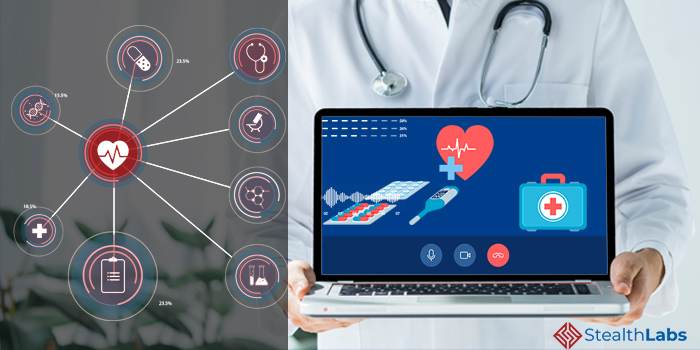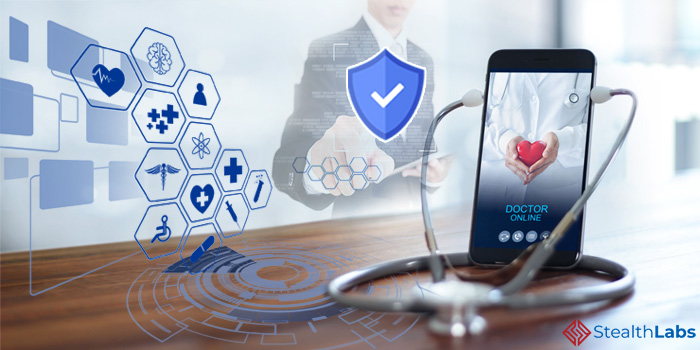Among all industries, healthcare has always been at the forefront of adopting new technologies.
The need to improve patient safety and bend cost curve has been instrumental in initiating the digital revolution across the industry.
The healthcare industry has evolved over the years by adopting sophisticated technology solutions across various processes and procedures ranging from patient registration to data monitoring, from lab tests to self-care tools.
The result is what we see around as Electronic Health Records (EHR), self-service kiosks, healthcare apps, wireless brain sensors, remote health assistance, and more
Among them, Telemedicine is one of the most promising advancements in the healthcare industry.
Telemedicine: An Emerging Medical Advancement!

Telemedicine or Telehealth is the practice of delivering health-related services and information to patients remotely.
The American Telemedicine Association (ATA) defines telemedicine as “the use of medical information exchanged from one site to another via electronic communications to improve a patient’s clinical health status.”
Instead of waiting for face-to-face appointments, patients can now communicate virtually with doctors and other medical professionals to receive instant medical advice and diagnosis.
Telehealth gives patients various access points to healthcare, irrespective of time and place. It is especially helpful for patients suffering from chronic conditions as it provides them with consistent, convenient, and cost-effective care.
A large-scale study published in CHEST Journal revealed that patients in an intensive care unit equipped with telehealth services were discharged from the ICU 20% more quickly and saw a 26% lower mortality rate than patients in a regular ICU.
Even though telemedicine comes with these immense benefits, it also poses cybersecurity risks.
Potential Cybersecurity Risks in Telemedicine

“Just like hygiene in the health sector, digital hygiene needs to be an instinctive reaction for health professionals,” says Bernard Cassou-Mounat, ANSSI Health Sector Co-ordinator.
Telemedicine providers must be diligent in order to manage and mitigate patients’ privacy and security concerns. When not implemented carefully, the telemedicine rollout can put patient’s Personal Health Information (PHI) at risk.
Telehealth adds to the risk exposure in key areas of cyber risks, such as:
- Technology failures
- Lack of informed consent
- Complex identity and access management
- Increased compliance requirements
- Physical security risks
- Legacy IT infrastructure
- Unpatched software in consumer environments
- Increased third-party risks
In fact, in a recent Deloitte survey of US physicians and healthcare consumers, almost one-third of respondents cited the security and privacy of patient health information as the chief concern in telemedicine.
So, organizations must execute a cyber strategy that mitigates these cybersecurity concerns and clears the way for greater adoption.
How to Address Cybersecurity Risks in Telemedicine?
Implement the following best practices to shore up your security posture and protect your client’s sensitive information:
1) Secure Devices and Accounts
All personal devices and accounts used by the physicians and healthcare customers to access personal health information must be secured. Continuous identity authentication ensures that the right individuals have access to the right data.
The identity authentication should take the form of Multi-factor Authentication (MFA).
MFA is the leading way for telemedicine providers to confirm patient identity over digital channels. One can also supplement MFA with biometrics (touch or facial recognition in a mobile app), SMS texts, or device fingerprinting.
Besides, the MFA can benefit the patients by removing the need for a password to use virtual health.
2) Secure Networks
Apart from securing individual devices and accounts, it’s imperative to ensure that any network connected to these devices are safe.
Public Wi-Fi networks offer internet accessibility at the cost of privacy risks. Since anyone can access these networks, the connected devices can become easy targets for eavesdropping, phishing, and hacking, leading to a data breach.
A Virtual Private Network (VPN) is one of the best solutions to this problem.
A VPN is private. Only individuals with access credentials can connect to the network. Moreover, VPNs are encrypted, making it difficult for cybercriminals to access data without the correct encryption key.
3) Practice Security
Patient portals, web page content, email communications, cloud storage, programs, applications, and downloads can open loopholes for cybercriminals to exploit. Hence, healthcare providers and patients should practice security protocols.
Some of the security hygiene practices include
- Accept only approved downloads from trusted sources
- Set firewall protections on all business devices
- Avoid downloading any software that could compromise cybersecurity
- Using a VPN during telehealth services and for general device usage as well
- Frequently update all apps and operating systems, not just telehealth platforms
- Always enable anti-malware and virus scans to run
- Restrict app permissions to what’s necessary for app functionality only
Above all, the telemedicine providers should follow HIPAA standards and guidelines regarding how patient information is being processed and protected.
Telemedicine and HIPAA

Along with the increasing technological advancements in the healthcare industry, the rules and regulations concerning the use of technology are also evolving.
Regulations such as the Health Insurance Portability and Accountability Act (HIPAA) target security concerns of health information and the steps that must be implemented to maintain privacy in the digital world.
HIPAA guidelines are as follows:
- Only authorized users must be able to access electronically Protected Health Information (ePHI)
- Systems that can monitor ePHI communications should be implemented to prevent malicious or accidental breaches
- The integrity of ePHI should be protected by implementing a system of secure communication – Insecure channels of communication like Skype, email, and SMS are not acceptable for communicating ePHI at distance
In practice, these guidelines mean that not only does patients’ information need to be stored securely but that all communications involving this information must also take place via secured platforms.
In Conclusion
In a bid to leverage the benefits of telemedicine, it’s crucial to have a firm understanding of the cyber risks associated with new technology.
The providers must continuously monitor, review, and update all communications to ensure that all the platforms are secure and safe. Moreover, one must stay abreast of the emerging cybersecurity threats to proactively secure telehealth data.
StealthLabs is Here to Help!
Stealthlabs is a US-based Cybersecurity service provider with years of industry presence and strong domain expertise. Our pool of experts helps companies comply with various data security laws and compliance standards, including HIPAA, GDPR and CCPA.
More Cybersecurity Articles:
- Steps to Create An Information Security Program Plan
- Telemedicine and Cybersecurity: Securing Health Data!
- Infographic – Cybersecurity Myths Vs Reality
- Cybersecurity Myths and Misconceptions Worth Knowing!
- Difference between Data Security and Data Privacy
- Top 8 Mobile Cybersecurity Threats You Should Know to Protect Your Data!
- 4 Ways MSSPs Can Improve Their Security Offering Through Automation
- Cybersecurity Threats to Be Aware of in 2020

